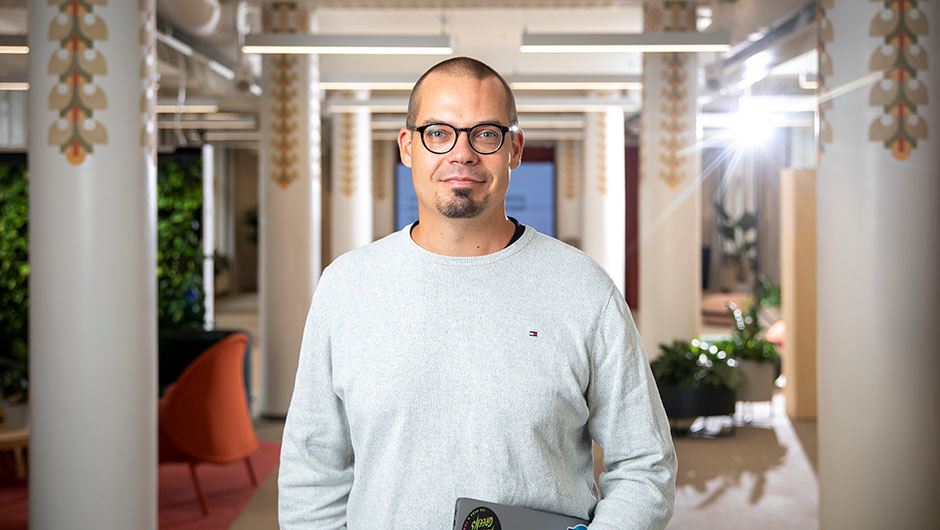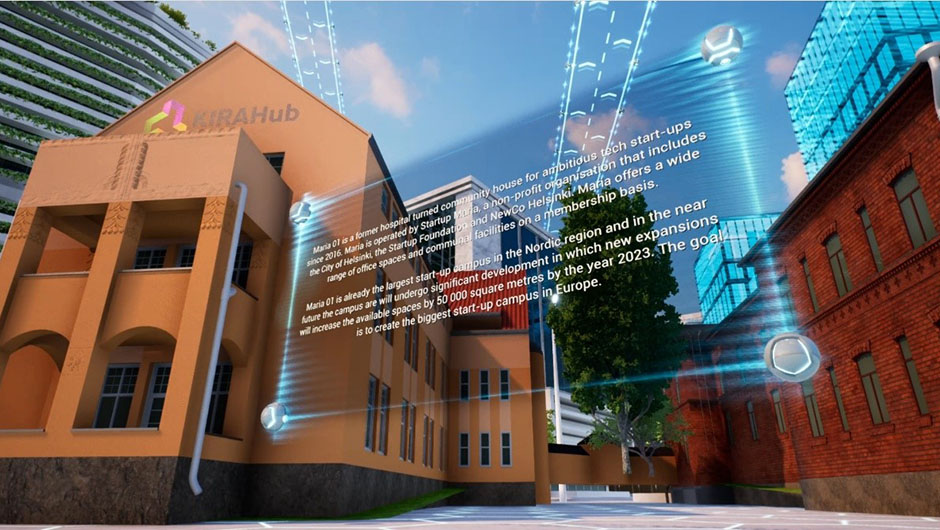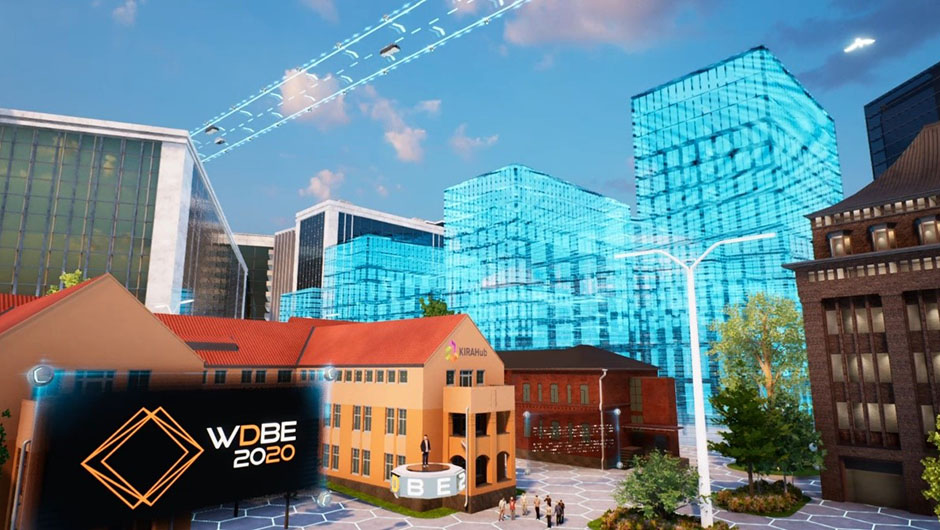The digital leap of the built environment and construction sector is still ahead, and KIRAHub CEO Teemu Lehtinen and his team aim to speed it up in a sustainable way.

"How could we lead the development of construction and building technologies in the right direction, in a way that acknowledges the potential of the industry's economical, ecological, and social impact?"
The question is asked by Teemu Lehtinen, the CEO of the non-profit association KIRAHub.
Whereas many other industries have managed to take massive leaps in their productivity with the help of ICT, the construction and building industry – an entity that is the biggest industry in the world – is lagging. According to Lehtinen, it's development has even slowed down in statistics in recent years.
The association, led by Lehtinen, aims to speed up the sustainable digital development of the industry by acting as a transparent platform for discourse that is aiming at concrete changes on all ends of the field.
KIRAHub is a continuation of the KIRA-Digi key project by Finland's previous government. The project was looking for ideas and providing funding for open-for-all digital experiments in the built environment and construction sector. In just three years the project involved 550 companies and organizations, and they funded close to 140 ideas. All of the project results are openly applicable for the industry to use, and they have been utilized even in Singapore (thanks to Google Translate).
"We did some calculations after the project and concluded that if all of these ideas were scaled for every process and service in Finland, it would mean a potential financial benefit of 5,5 billion euro every year," Lehtinen says.
Since the project was a huge success, several associations in the industry decided to found KIRAHub to continue its work. The association aims to measure the digital development of the industry not only from an economic but also from social and ecological points of view.
"After the project, we also worked on a digital model in which we disclosed all of these points and proportioned each idea with how much was invested in it. One thing that we learned was that the euros put into individual experiments didn't correlate with its overall impact. Instead, many ideas required a lot less money but had a bigger impact."
KIRAHub aims to boost the sustainable digitalization of the built environment in different ways. That includes not only the processes between companies but also how digitalization could make life easier and help in providing services that improve the quality of life. As Lehtinen sees it, improving smart locking systems is at the core of this development.
In case all Finnish apartments had smart locks, services that help you fill your fridge or place cleaned and ironed clothes in the wardrobe without having to go grocery shopping or washing the clothes yourself could be easily developed.
"This means that in case the customer wants, the service provider could have access to the home," Lehtinen explains.
Lehtinen knows that changing the siloed industry is challenging – especially because there is no single entity managing the change. Instead, property owners, residents, planners, and customers operate freely with each other. Change requires someone to take the lead, and that is what KIRAHub is for: as a neutral agent, it aims to help the whole ecosystem renew itself and to create new abilities, and also to create new, integrated processes and shared platforms. The association wants to help all the operators in the industry in utilizing the possibilities of digitalization more effectively and in a more justifiable way.
Data and its free flow are one of the key factors in this wide field with plenty of different interest groups.
"Maria is the right place for us now and in the future"
Since the KIRAHub team consists of three people, the association doesn't require an actual office. Yet, they wanted to create an identity for their operations, and also a possibility to be associated with a space that would also support the ecosystem work and operations of the association. There was also a need to find a testbed for digital innovation of built environment so that different companies can test their concepts and, when necessary, scale them for wider use. Finding the right space from Maria 01 was a matter of a small coincidence.
"The renovation of the Sonck building was almost over, and they offered us half a floor for our use. Together with our partners we started planning the space and as a result, there is now a multifaceted space called Urban3 that functions as an open meeting place for the ecosystem," says Lehtinen.
Choosing Maria 01 was not just a hit-and-miss, though. Lehtinen considers Maria surroundings to be great for exposing his industry to other industries as well. As digitalization doesn't care about the country or industry boundaries, Lehtinen is looking forward to old industry barriers breaking when they come into contact with different industries. The ongoing coronavirus situation has indicated in many ways how different industries affect each other – especially since everything we do is basically within the four walls of our apartments, and services and hobbies are taken to homes. Lehtinen believes that there are infinite possibilities that should not stop at any pre-determined boundaries.
"We wanted to enable a wider cross-pollination and be a part of a larger ecosystem. There are startups and investors around us that can be of great use in developing our functions. What's great about Maria is that it's located close to the Helsinki city centre, the ambitious growth objectives of the campus, a wide range of ecosystem players, and of course the interesting story behind everything."
KIRAHub-hosted Urban3 premises can be used in different ways. The aim was to make the space inspirational for daily work, workshopping, as an event space, co-working, conferences, and as a showroom for new concepts, projects, and activities.
Lehtinen sees the expanding of the Maria campus into one of Europe's largest growth and technology hubs as an excellent thing, since it will also bring about new possibilities for KIRAHub's operations with its new members. The Maria campus could become a one-stop-shop for international visitors and delegations hoping to learn more about all the knowledge and advancement Finland has to offer.
"It also reinforces the way we see Maria as the right place for KIRAHub now and in the future."
Because of the ongoing COVID-19 pandemic, the number of physical events has been reduced to a minimum, and that has made the KIRAHub crew work on virtual possibilities for connecting hubs in different countries. There is a need for combined platforms with which you could be connected to different companies without the need to fly over. KIRAHub has already created a precise 3D model of the Urban3 premises that enables digitally developing the space. In the future, the virtual space could be utilized for example in interaction, and letting visitors from the other side of the world come and get to know the virtual space and also take part in all the space's physical activity.
"Naturally, the expansion is interesting to us also because it is a massive construction project that is thus connected to our industry."
What is the role of digitalization on the future Maria campus?
Lehtinen believes that if you think about the Maria area first and foremost as a campus and pay less attention to the current remote work situation caused by the pandemic, digitalization will bring several benefits for the maintenance and the user experience of the Maria premises. By making the premises smart they could be controlled proactively in a way that would prevent construction debt from growing too big – instead, the premises could be maintained so that their functionalities won't suffer.
"This has also to do with the circular economy: when we have data of the materials used in a building, we can already have new plans for all the old materials when it's time for renovating or replacing materials."
Data and digital solutions can also improve the user experience of spaces. Finding different spaces such as conference rooms, lunch spots, or other services will be easier, and so is organizing the evening and weekend use of spaces. A more versatile and encompassing use of spaces would also be smart from a sustainability point of view, as you could maximize the use of spaces that already exist instead of building new ones.
Lehtinen thinks these things are highlighted in this 'new normal' era as knowledge workers can work anywhere. That means that current working spaces can be utilized by a larger amount of people than before.
"These days no-one should have their dedicated working desks. Instead, they should be smart and open to anyone. You should be able to reserve a desk from any working space on the campus, and it would be disinfected and cleaned up before every use. It would also know the exact time of the user's arrival, and you could adjust its temperature and maybe even the background music. These things can be offered for different target groups, but it can't be done without digitalization and the data we can get from the desks," Lehtinen says.
The original idea of the campus has been to enable and increase encounters, but in case we keep living in a world where a significant share of all work is done remotely, we must find new ways to promote physical and virtual encounters. If the actions of all the members of a community are transparent, the well-being of the community is possible in the interface of the virtual and the physical. Lehtinen says that one big question that needs to be answered is how people can be connected and their needs identified in case they cannot meet each other in physical spaces. He believes that once we find the answer, the world will open up and city and country borders lose their meaning.
"It's so valuable to be able to scale the interaction globally to similar communities. It would also support our global co-operation, and we wouldn't need to fly as much in the future either," Lehtinen says.
Events are possible also during the pandemic, thanks to digitalization
When the global COVID-19 pandemic changed KIRAHub's plans for their third annual World Summit on Digital Built Environment (WDBE) event, the association ended up testing their digitalization principles in action. Each year the event brings professionals from different countries to Finland to share their knowledge on their own country's built environment and construction sector. Public and private sector professionals take the stage at WDBE, accompanied by representatives from tech giants that have some kind of a connection to built environments, such as Amazon, Microsoft, and Uber.
"We want to send a message that also operators outside our industry are interested in what we do and how this field should be developed further," Lehtinen says.
This year, WDBE was supposed to be organized together with Estonia by hosting the event's first day in Helsinki and the second day in Tallinn. When the organizers realized a physical event could not take place, they decided to carry out the event in a new way. That's why they decided to make it virtual. Together with Helsinki-based Zoan, the company behind the Finnish pop-rap duo JVG's famous virtual first of May concert, and the American Epic Games, they constructed the world's first virtual event of the built environment and an illusionary city of the future that has elements of both Tallinn and Helsinki.
Even though there were some challenges in carrying out the virtual WDBE, Lehtinen and his team were very satisfied with the outcome – as was the majority of the visitors. The team hasn't yet decided what kind of event they will host next year, but because of the positive experience, a hybrid of a physical and a virtual event just might work.
"A two-day sprint is always somewhat challenging. Instead, we have thought about developing a platform where we could host smaller events throughout the year."
Virtual and physical events require different things from event premises. A part of the WDBE pre-events took place as hybrid events, where the Maria space was used as a live stream studio. The speakers were present, but most of the attendees joined remotely.
From technology's point of view, such an event requires the space to have a sufficient and high enough quality internet connection so attending the event would be as smooth as possible. There are also some requirements for functioning interaction: even though video conference apps such as Zoom have breakout rooms for workshopping in smaller groups, how can that be enabled in physical spaces, too? The Urban3 open space has been designed in a way that digitalization and service design supports different ways of attending, whether it is done physically or virtually.
"Collecting notes is also different when you don't have the actual post-it notes or whiteboards for writing. It takes a little patience from the attendees to learn how to use the online counterparts of such tools, but then again, there are a lot of benefits in mastering them: thanks to the online tools the notes are automatically digitalized which means that no one needs to collect and combine them afterwards," says Lehtinen.
Urban3: interior design Mint&More & images Esa Kapila
WDBE & Maria 01, images Zoan







